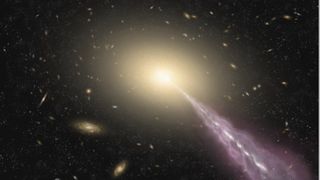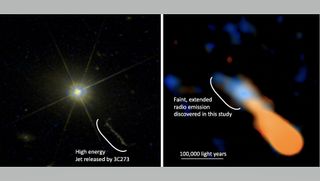Strange 'unknown structure,' a faint radio glow thousands of light-years wide, found around closest quasar
The closest quasar to the Milky Way is giving up its secrets, thanks to an innovative technique developed by Japanese astronomers.

A new technique for studying some of the brightest objects in the universe has thrown a curveball into scientists' understanding of the link between active monster black holes and the suppression of star formation.
Quasars are the ultraluminous cores of galaxies that contain extremely active supermassive black holes. A quasar's intense radiation originates from massive amounts of hot gas forming an accretion disk around the black hole's maw.
Using the Atacama Large Millimeter/submillimeter Array in Chile (ALMA), researchers targeted the quasar 3C 273. At 2.4 billion light-years from Earth, 3C 273 is the closest quasar to the Milky Way and the first quasar ever to be identified. Yet the glare of the quasar's light makes it difficult to observe the rest of its host galaxy, particularly at the radio wavelengths used by ALMA.
Related: Behold the mighty quasar: The science of galactic lighthouses
Seeing bright and faint features in the same camera shot requires a property known as a high dynamic imaging range. A typical digital camera has a dynamic imaging range of thousands, compared with only the low hundreds for ALMA, meaning it's difficult for ALMA to pick out faint details set against brighter features.
So the research team, led by Shinya Komugi of Kogakuin University in Japan, employed a new technique they call "self-calibration." The trick is to reduce the glare from the quasar by using 3C 273 itself to correct for the fluctuations in Earth's atmosphere that can affect ALMA's detection of submillimeter radio waves.
This method results in increased contrast. ALMA observed 3C 273 at frequencies of 93, 233 and 343 GHz, and the self-calibration technique allowed for dynamic imaging ranges of 85,000, 39,000 and 2,500, respectively — the highest dynamic ranges ALMA has ever achieved.
Get the Space.com Newsletter
Breaking space news, the latest updates on rocket launches, skywatching events and more!
The technique revealed never-before-seen details about 3C 273's host galaxy, including what the scientists described as an "unknown structure" in a statement on the discovery. Komugi's team saw a faint band of radio emission across the host galaxy stretching for tens of thousands of light-years. This radio emission is coming from tens of billions to hundreds of billions of solar masses' worth of hydrogen gas that has been ionized by the ultraviolet and X-ray radiation from the quasar.

Astronomers strongly suspect that there is a connection between the radiation output from active supermassive black holes and the suppression of star formation in their host galaxies. The radiation pouring out of the accretion disk acts as negative feedback, heating molecular hydrogen gas so it can no longer form stars.
However, there appears to be plenty of cold molecular hydrogen gas remaining in 3C 273's host galaxy, and star formation is ongoing. So, either the connection between feedback from the quasar and the cessation of star formation isn't as concrete as scientists thought, or we may be catching 3C 273 and its galaxy in the short time frame before the effects of the feedback become apparent.
Komugi's team is now observing other quasars in a similar way to get a broader understanding of these processes.
"By applying the same technique to other quasars, we expect to understand how a galaxy evolves through its interaction with the central nucleus," Komugi said in a statement.
The research was published online in April in The Astrophysical Journal.
Follow Keith Cooper on Twitter @21stCenturySETI. Follow us on Twitter @Spacedotcom and on Facebook.
Join our Space Forums to keep talking space on the latest missions, night sky and more! And if you have a news tip, correction or comment, let us know at: community@space.com.

Keith Cooper is a freelance science journalist and editor in the United Kingdom, and has a degree in physics and astrophysics from the University of Manchester. He's the author of "The Contact Paradox: Challenging Our Assumptions in the Search for Extraterrestrial Intelligence" (Bloomsbury Sigma, 2020) and has written articles on astronomy, space, physics and astrobiology for a multitude of magazines and websites.
